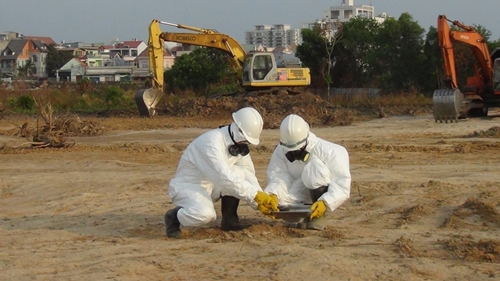According to Major General Ha Van Cu, although 60 years have passed since U.S. military started to conduct its chemical warfare in Vietnam on August 10, 1961, the Vietnamese people are still suffering severe consequences of toxic chemicals that U.S. soldiers sprayed on the country.
According to statistics reviewed at an international seminar on Agent Orange/dioxin in Hanoi in August 2016, between 1961 and 1971, the U.S. armed forces used 80 million liters of toxic chemicals, 60% of which contained Agent Orange/dioxin, and over 9,000 tons of CS chemicals, severely poisoning the environment in provinces and cities in Military Regions 4, 5, 7, and 9. The chemicals were sprayed over 26 hamlets, with a total area of 3.06 million hectares (equal to a quarter of the total area of Southern Vietnam), making more than 4.8 million people be exposed to the toxic chemicals. Six decades have passed by, but Bien Hoa, Da Nang, Phu Cat, and A So airports, are still severely contaminated with dioxin, as they were U.S. military’s chemical storehouses in wartime.
General Cu wrote that toxic chemicals’ long-lasting harmful effects on people’s health and environment were pointed out at different international seminars in 1993. At these events, scientists affirmed that U.S. military’s Agent Orange/dioxin destroyed nature and plants, human’s health, causing serious diseases and genetic disorders through fathers or mothers, birth defects, congenital malformation, and cancers, among others.” Many research projects, conducted by the National Committee for the Investigation of Consequences of Toxic Chemicals, National Steering Committee on Overcoming Consequences of Toxic Chemicals, the Chemical Corps, the Vietnam-Russia Tropical Center, the Military Medical University and U.S., Japan and Canadian scientists, have also proven the impacts of Agent Orange/dioxin on the environment and the Vietnamese people.
Cu added that there is an undeniable fact that tens of thousands of former Vietnamese soldiers and their descendants are living with deformities and diseases caused by the chemical’s effects.
According to him, the Chemical Corps is a vanguard force in conducting surveys and dioxin-contamination remediation projects. Considering the task one of the combat missions of chemical troops in peacetime, the Chemical Corps has over the past time made recommendations to the Party, State and the Ministry of National Defense to issue different policies and projects on overcoming consequences of toxic chemicals. Chemical units have closely cooperated with military and civilian units to study and devise CS and dioxin-remediation techniques. Particularly, since 1996, the Chemical Corps has conducted more than 20 projects on settling post-war toxic chemical consequences in different localities. Together with detoxifying around 150,000 cubic meters of the contaminated soil in Bien Hoa Airport, the force has made technical consultations to accelerate the detoxification of contaminated soil in Phu Cat Airport and supervised the implementation of the technology used for processing dioxin-contaminated soil in Da Nang Airport. These achievements have made significant contributions to national socio-economic development and overall assessment of chemical contamination in localities. In addition, the force’s data collected during investigation serve as bases for relevant agencies to outline suitable dioxin remediation projects for different locations.
Apart from Vietnam’s inner efforts in settling post-war toxic chemicals, the country has cooperated with international organizations in dealing with toxic chemical consequences, Cu added.
    |
 |
|
Chemical troops processing post-war toxic chemicals |
The Commanding General of the Chemical Corps noted that Vietnam has mobilized its maximum efforts and resources to overcome heavy consequences of war over the past time, but the results have been modest. He said that clearing dioxin-contaminated areas and preventing dioxin from spreading is an urgent and time- and money-consuming mission, requiring the joint effort of agencies, industries, the whole political system and people across the countries with chemical troops as a vanguard force. To complete the mission, he urged participating forces to take both short- and long-term measures, including information dissemination, force building, investment in processing equipment, collaboration with local forces and international cooperation.
He affirmed that dissemination of higher levels’ guidelines and policies on overcoming post-war toxic chemical consequences should be promoted, so as to raise officers’ and soldiers’ awareness of the importance of the settlement of AO/dioxin in national building and development. He also emphasized the need to build competent human resource and upgrade new technical equipment to raise the quality and effectiveness of dioxin detoxification in the coming time.
Major General Ha Van Cu stressed that detoxifying dioxin-contaminated land is a difficult and money-consuming mission, so the chemical force should accelerate studying, developing and mastering new processing technologies for dioxin contamination to both save money and soon free remaining hotspots from dioxin contamination in Vietnam.
He added that as a vanguard force in the mission, the Chemical Corps should foster information dissemination and close coordination with agencies, sectors, forces, local authorities, and international organizations to successfully fulfill assigned missions.
Concluding his article, the commanding general of the Chemical Corps encouraged the chemical force to take advantage of financial resources, update itself with new technologies, and seek technical transfer from countries with scientific advances and technologies in order to choose appropriate technological solutions to the treatment of Agent Orange/dioxin-contaminated “hotspots” in Vietnam.
Translated by Tran Hoai